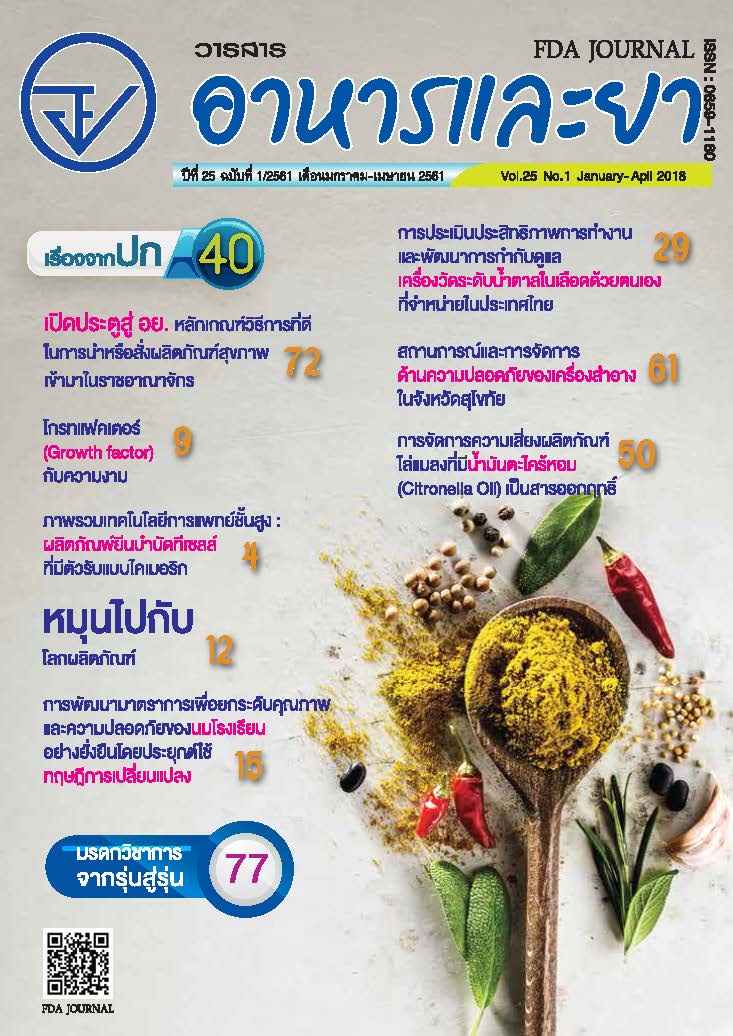การพัฒนามาตรการเพื่อยกระดับคุณภาพและความปลอดภัยของนมโรงเรียนอย่างยั่งยืน โดยประยุกต์ใช้ทฤษฎีการเปลี่ยนแปลง
Main Article Content
บทคัดย่อ
การศึกษานี้มีวัตถุประสงค์เพื่อจัดทำมาตรการแก้ปัญหาในระบบนมโรงเรียนให้เกิดความยั่งยืน เพื่อให้ผลิตภัณฑ์นมพร้อมดื่มมีคุณภาพและปลอดภัยโดยประยุกต์การวิเคราะห์ตามทฤษฎีการเปลี่ยนแปลง (Theory of Change) เป็นกระบวนการศึกษาเชิงคุณภาพ ซึ่งมีการวิเคราะห์เอกสารที่เกี่ยวข้องกับการพัฒนาความปลอดภัยของนมโรงเรียนที่ดำเนินการอย่างต่อเนื่องตั้งแต่ปี พ.ศ. 2539 จนถึงปัจจุบัน ดำเนินการที่มาตรการควบคุมและจัดการความเสี่ยงในการผลิตนมโรงเรียนโดยหน่วยงานภาครัฐ ครอบคลุมตลอดห่วงโซ่ตั้งแต่การผลิตน้ำนมดิบ การแปรรูป การขนส่งและการแจกจ่าย ทั้งที่เป็นมาตรการทางกฎหมาย เช่น การกำหนดมาตรฐานด้านคุณภาพและความปลอดภัยของนม การกำหนดมาตรฐานกระบวนการผลิต GMP ผลิตภัณฑ์นมพร้อมดื่ม และมาตรการที่ไม่เป็นกฎหมาย เช่น เกณฑ์การรับซื้อนมดิบ เกณฑ์การพิจารณาให้เป็นคู่สัญญาในการจัดส่งนมโรงเรียน อีกทั้งมีมาตรการเชิงพัฒนา เช่น การพัฒนาสถานที่ผลิตนมพร้อมดื่มพาสเจอร์ไรส์ขนาดกลางและขนาดเล็กทั่วประเทศ (ดำเนินงานระหว่างปี 2542-2547) การสร้างระบบการตรวจติดตามคุณภาพภายในของสถานที่ผลิตขนาดกลางและขนาดเล็กเพื่อให้เกิดความต่อเนื่องและยั่งยืนของระบบ GMP (พ.ศ. 2548-2549) การจัดตั้งศูนย์เรียนรู้และฝึกอบรมผู้ควบคุมการผลิตนมพร้อมดื่มพาสเจอร์ไรส์ เป็นต้น ผลของการประมวลเอกสารจากการดำเนินงานเฝ้าระวังคุณภาพผลิตภัณฑ์และ GMP สถานที่ผลิต โดยเปรียบเทียบ 2 ช่วง ระหว่างปี 2553-2555 และช่วงปัจจุบัน (พ.ศ.2558-2560) พบว่าทั้ง 2 ช่วงเวลา มีจำนวนผลิตภัณฑ์ที่ไม่เป็นไปตามมาตรฐานในสัดส่วนที่ใกล้เคียงกันคือประมาณร้อยละ 4-5 ขณะที่ผลการประเมิน GMP สถานที่ผลิตส่วนใหญ่เป็นไปตามเกณฑ์ที่กำหนด ซึ่งสะท้อนให้เห็นว่ามาตรการต่างๆ ที่ภาครัฐดำเนินการในห่วงโซ่อุปทานนมนั้น อาจมีจุดที่ต้องการการพัฒนา จากการวิเคราะห์ตามกรอบแนวคิดทฤษฎีการเปลี่ยนแปลง สันนิษฐานตัวกระทำให้เกิดการเปลี่ยนแปลง (Determinant) ที่ยังขาดในห่วงโซ่อุปทานนม คือ สมรรถนะของบุคลากรที่เกี่ยวข้องกับห่วงโซ่อุปทานนม เนื่องจากเป็น determinant ที่ยังไม่ได้มีการกำหนดมาตรการใดๆ รองรับตามที่แสดงในข้างต้น ดังนั้น จึงได้ดำเนินการพัฒนาหลักสูตรการฝึกอบรมพัฒนาสมรรถนะบุคคลากรที่เกี่ยวข้องตลอดห่วงโซ่เพื่อเป็นข้อเสนอให้มีการบังคับใช้ต่อไป
Article Details
เอกสารอ้างอิง
2.สถาบันอาหาร. (2559). อุตสาหกรรมโคนม [ออนไลน์]. เข้าถึงข้อมูลวันที่ 29 มกราคม 2561. จาก http://fic.nfi.or.th/foodsectordatabank-detail.php?id=31
3. มติชนออนไลน์. (2559). ข่าววันที่ 13 มิถุนายน 2559 หัวข้อ “เกิดอีกที่โคราช นร.กว่า 30 คน ถูกหามเข้า รพ. อาเจียนหนักหลังดื่มนมโรงเรียน” [ออนไลน์]. เข้าถึงข้อมูลวันที่ 29 มกราคม 2561. จาก https://www.matichon.co.th/news/171463
4. หนังสือพิมพ์ข่าวสดออนไลน์. (2560). ข่าววันที่ 7 กุมภาพันธ์ 2560 หัวข้อ “หาม 20 นักเรียนปทุมธานีส่ง รพ.วุ่น หลังดื่มนมบูดแล้วท้องเสีย-อาเจียนหนัก” [ออนไลน์]. เข้าถึงข้อมูลวันที่ 29 มกราคม 2561 จากhttps://www.khaosod.co.th/around-thailand/news_210181
5. ศุภวัฒน์ ปภัสสรากาญจน์. (2559, มกราคม-มีนาคม). การนำทฤษฎีการเปลี่ยนแปลงและตัวแบบตรรกะเพื่อการปรับตัวด้านภูมิอากาศมาใช้ในการพัฒนาชุมชนและท้องถิ่น. วารสารการบริหารท้องถิ่น. 9(1), 41-59.
6. Clark, H., Anderson, A.A. (2004). Theories of Change and Logic Models: Telling Them Apart. Paper presented at American Evaluation Association, Atlanta, Georgia [Online]. Retrieved January 22, 2018 from https://www.theoryofchange.org/wp-content/uploads/toco_library/pdf/TOCs_and_Logic_ Models_forAEA.pdf.
7. Taplin, D.H., Clark, H. (2012). Theory of Change Basics. A primer on Theory of Change [Online]. Retrieved January 22, 2018 from http://www.theoryofchange.org/wp-ontent/uploads/toco_library/ pdf/ToCBasics.pdf
8. Gill, P., Stewart, K., Treasure, E., Chadwick, B. (2008). Method of data collection in qualitative research: interview and focus groups. British Dental Journal, 204(6), 291-295.
9.Stemler, S. (2001). An overview of content analysis. Practical Assessment, Research and Evaluation. 7(1), 1-6.
10.FAO (Food and Agriculture Organization of the United Nation). (2007). Strengthening National Food Control Systems, A quick guide to access capacity building needs [Online]. Retrieved January 22, 2018 from at http://www.fao.org/3/a-a1142e.pdf.
11. กองควบคุมอาหาร สำนักงานคณะกรรมการอาหารและยา. (ม.ป.พ.) คู่มือเรื่อง มารักษาคุณภาพนมโรงเรียนกันเถอะ ฉบับผู้ประกอบการ [ออนไลน์]. เข้าถึงข้อมูลเมื่อ 31 มกราคม 2561 จาก http://food.fda.moph.go.th/data/news/2558/sum_newser/School-milk/Quality_milk_manual(manufacturer).pdf.
12. เวณิกา เบ็ญจพงษ์. (2550). คู่มือการขนส่งและการเก็บรักษานมชนิดพาสเจอร์ไรส์ในถังแช่นม. โครงการวิจัยการทดสอบรูปแบบการขนส่งและการเก็บรักษานมโรงเรียนในสถานการณ์จริง. กรุงเทพฯ: สถาบันคลังสมองของชาติ.
13. สุณีรัตน์ เอี่ยมละมัย, อดุลย์ วังตาล และจุไรรัตน์ ถนอมกิจ. (2556). รายงานวิจัยเรื่องมาตรฐานความปลอดภัยอาหารตลอดห่วงโซ่การผลิตเพื่อสนับสนุนการขับเคลื่อนยุทธศาสตร์ความปลอดภัยอาหาร: น้ำนม (รายงานการวิจัยฉบับสมบูรณ์เสนอต่อ สกว. สัญญาเลขที่ RDG5520062). กรุงเทพฯ. (อัดสำเนา)
14. Choung, J. (2010). An Analysis of Restaurant Food Safety Violations: Human Factors, Non-human Factors, and Food-borne Illness. M.Sc. Thesis in Hotel Administration. William F. Harrah College of Hotel Management. University of Nevada Las Vegas, USA.
15. Shirani, M., Demichela, M. (2015). Intergrated of FMEA and Human Factor in the Food Chain Risk Assessment. International Journal of Economics and Management Enginerring. 9(12), 4247-4250.


